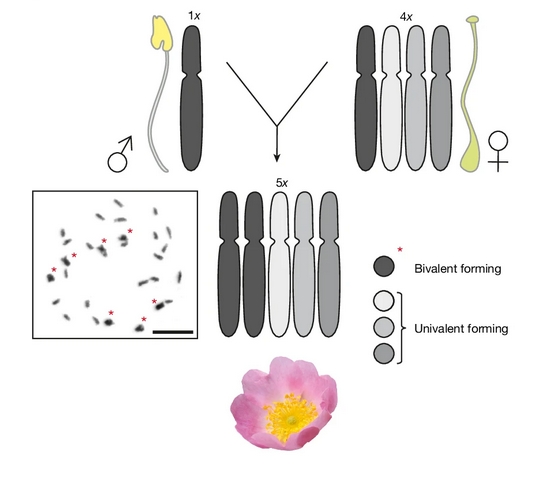Published: 18 June 2025
Abstract
Sexual reproduction relies on meiotic chromosome pairing to form bivalents, a process that is complicated in polyploids owing to the presence of multiple subgenomes1. Uneven ploidy mostly results in sterility due to unbalanced chromosome pairing and segregation during meiosis. However, pentaploid dogroses (Rosa sect. Caninae; 2n = 5x = 35) achieve stable sexual reproduction through a unique mechanism: 14 chromosomes form bivalents and are transmitted biparentally, while the remaining 21 chromosomes are maternally inherited as univalents2,3. Despite being studied for over a century, the role of centromeres in this process has remained unclear. Here we analyse haplotype-resolved chromosome-level genome assemblies for three pentaploid dogroses. Subgenome phasing revealed a bivalent-forming subgenome with two highly homozygous chromosome sets and three divergent subgenomes lacking homologous partners, therefore explaining their meiotic behaviour. Comparative analyses of chromosome synteny, phylogenetic relationships and centromere composition indicate that the subgenomes originated from two divergent clades of the genus Rosa. Pollen genome analysis shows that subgenomes from different evolutionary origins form bivalents, supporting multiple origins of dogroses and highlighting variation in subgenome contributions. We reveal that bivalent-forming centromeres are enriched with ATHILA retrotransposons, contrasting with larger tandem-repeat-based centromeres mainly found in univalents. This centromere structural bimodality possibly contributes to univalent drive during female meiosis. Our findings provide insights into the unique reproductive strategies of dogroses, advancing our understanding of genome evolution, centromere diversity and meiotic mechanisms in organisms with asymmetrical inheritance systems.
